| Twin-Path Extra Slings in Action |
|
Twin-Path® Extra Slings are the single greatest advance in the history of the rigging world. Leave the crushed fingers, back injuries, forklifts, transport vehicles and auxiliary cranes in the past. Super strong, ultra light, Twin-Path® Extra Slings allow sling users to do more, in less time, with less effort. Given the choice and the assumption of proper application, any informed rigger will select Twin-Path® Extra Slings.
The 200 ton generator rotor was easily handled with Twin-Path® Extra Slings. Each 56 ft. sling rated at 250,000 Lbs. Basket Work Load weighs a mere 169 pounds. One man rigged while three assistants viewed the process. The ease of handling reduced the normal two day procedure to several minutes. The improved process was heralded as one of the easiest ever performed by the rigging crew at the nuclear power generation facility.
|
|
|
|
Lift-It® was one of the original Slingmax® Licensees and we have been fabricating Twin-Path® Slings for over twenty-four years. In the beginning, our competitors claimed that Twin-Path® Extra Slings were just a fad and a dangerous one at that. Twenty-four years later after thousands of lifts and millions of pounds safely handled, without incident, the same competitor now sells their version of “dangerous” high performance fiber slings they once warned against. The competition may now have high performance fiber slings, but they do not have patented and innovative
Twin-Path® Inspection Features. We have revolutionized the rigging industry and set records as Slingmax® Dealer of the Year on many occasions. We are honored in our association with Slingmax® and thank the many successful riggers that are making world record lifts with Lift-It® Twin-Path® Extra Slings.
Lift-It® was one of the original Slingmax® Licensees and we have been fabricating Twin-Path® Slings for over twenty-four years. In the beginning, our competitors claimed that Twin-Path® Extra Slings were just a fad and a dangerous one at that. Twenty-four years later after thousands of lifts and millions of pounds safely handled, without incident, the same competitor now sells their version of “dangerous” high performance fiber slings they once warned against. The competition may now have high performance fiber slings, but they do not have patented and innovative
Twin-Path® Inspection Features. We have revolutionized the rigging industry and set records as Slingmax® Dealer of the Year on many occasions. We are honored in our association with Slingmax® and thank the many successful riggers that are making world record lifts with Lift-It® Twin-Path® Extra Slings.
|
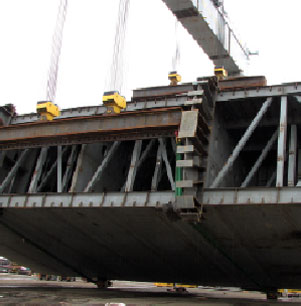 |
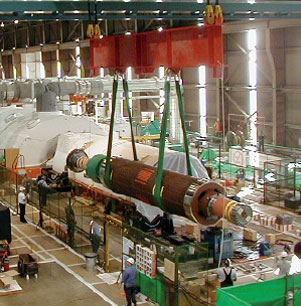 |
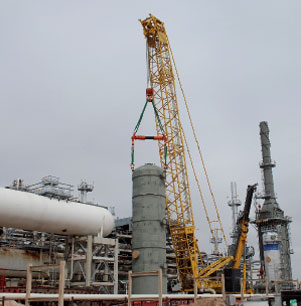 |
|
450 Ton Barge Section Rotation
|
207 Ton Power Turbine
|
200 Ton Refinery Vessel Installation
|
|
| Twin-Path Features |
|
Four, identical, single ply slings were fabricated from a single roll of webbing. All independent variables were controlled, as the same thread, machine and fabricator were used for this experiment. The slings (EE1-903) are rated at 4800 Lbs. vertical and we would expect 24,000 Lbs. break strength. The slings were pulled to destruction. The control sling broke at 26,050 Lbs. The other three slings were deliberately cut on one edge to simulate: 1/8 inch, 1/4 inch and 3/8 inch cuts. This seemingly “minor” damage resulted in very significant strength loss.
“Minor” damage is extremely serious and damaged slings must be removed from service, immediately and not used for other applications. Remember, there is ZERO tolerance for sling damage. Be pro-active and prevent sling damage from occurring by employing suitable Sling Protection.
|
Patented Back-Up Protection
|
|
Twin-Path® slings are actually two complete yet separate slings in one. Each path accounts for 50% of the total sling Work Load and makes its own separate connection between the hook and the load. Twin-Path® slings provide sling users redundant, back up protection.
|
|

|
|
Easy Inspection
|
|
Twin-Path® slings provide sling users with an early warning inspection system. The load bearing core yarn is encapsulated by Covermax® or polyester covers and does not contact the load. Cornermax® is made from a double layer industrial nylon material. If you see the inner, red cover, remove the sling from service and return it for repair evaluation.
|
|

|
|
Tattle Tails
|
|
Before each use, inspect the entire sling. Tattle Tails are not a precision force measurement device. Tattle tails are an extension of the load bearing core yarns. Tattle Tails will retract and eventually disappear as the sling is severely overloaded. Tattle Tails must extend past the tag area of the sling. Both Tattle Tails must be visible; if not, remove the sling from service for repair evaluation. If Tattle Tails or any part of the sling shows evidence of chemical degradation, remove it from service for repair evaluation.
|
|
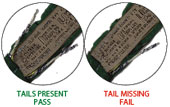 |
|
Fiber-Optic Inspection System
|
|
Only Twin-Path® Slings have a Fiber-Optic Inspection System. Fiber Optic Inspection assists sling users and inspectors in evaluating the condition of the load bearing core yarns. Core Yarn condition can be inspected by checking Fiber Optic cable conductivity. If Core Yarn has suffered chemical, heat or crushing damage, fiber optic cables will lose the ability to transmit light from one end to the other. Lack of light conductivity gives the inspector a reason to remove the sling from service and return it for repair evaluation. Fiber Optic cables will conduct light from overhead sources or flashlights. The inspector simply covers and removes a finger from one cable end and watches the other cable end for blinking, indicating conductivity. Fiber Optic Inspection combined with thorough visual and hand over hand inspection techniques provides inspectors the assurance slings are acceptable for use.
US Patent No. 5,651,572
|
|
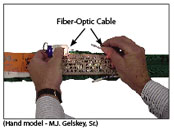 |
|
Check-Fast® Inspection System
|
|
4Check-Fast® Inspection provides users and inspectors a pass/fail inspection system for evaluating load bearing core yarn condition. Damage to core yarn from fiber on fiber abrasion, UV degradation and severe overload can be detected. The 4Check-Fast® tag and External Warning Indicator (EWI) make up the 4Check-Fast® Inspection System. If accidental overload beyond rated capacity occurs, the External Warning Indicator (EWI) will disappear before the sling fails. Sling users and inspectors now have an objective pass/fail inspection system that is not subjective. The 4Check-Fast® Inspection System combined with visual and tactile inspection techniques provides improved job site safety. Specify Check-Fast® by adding CF to the stock number, i.e., TUFXKS 4000 CF.
US Patent No. 7,661,737
|
|
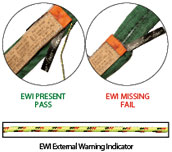 |
|
 Slings can fail if damaged, misused, or overloaded. Inspect before use. Damaged slings shall not be used. Do Not Exceed Rated Capacity. Protect sling from being cut by load edges, protrusions, corners and abrasive surfaces. Avoid exposure to damaging chemicals and temperatures over 180 degrees (F). DEATH or INJURY can occur from improper use or maintenance. Slings can fail if damaged, misused, or overloaded. Inspect before use. Damaged slings shall not be used. Do Not Exceed Rated Capacity. Protect sling from being cut by load edges, protrusions, corners and abrasive surfaces. Avoid exposure to damaging chemicals and temperatures over 180 degrees (F). DEATH or INJURY can occur from improper use or maintenance.
|
|
|
| Twin-Path Considerations |
|
TREMENDOUS SAVINGS: Time is money and the ease of handling ultra-light, Twin-Path® Extra Slings adds up to substantial, cumulative savings. TUFXKS 7000 x 35 ft. weighs a mere 49 Lbs. and is rated at 140,000 Lbs. Basket WLL. A wire rope sling of equal length and strength weighs 588 Lbs. Extra cranes, forklifts, transport vehicles and personnel are no longer required for Twin-Path® Extra Slings. They have documented savings and prove to be the least expensive sling you will buy and use.
USER FRIENDLY: Twin-Path® Extra Slings are easy to handle and will not “choke lock”, inhibiting sling removal from the load. Lightweight, Twin-Path® Extra Slings help eliminate typical and prevalent back, hand, foot and head injuries when using heavy, awkward, cumbersome wire rope and chain slings.
LOAD FRIENDLY: Twin-Path® Slings provide load protection and will not mar, scratch or deface the most delicate metallic surface. Twin-Path® Slings are equally gentle on non-metallic loads.
LOW ELONGATION: A Twin-Path® Extra Sling (TUFXKS 11000 x 328 in.), with High Performance, K-Spec® Core Yarn was vertically proof tested to 220,000 Lbs. After ten minutes, total elongation of 2 inches was recorded. Low elongation extends sling longevity as scraping over load surfaces is minimized.
PULLING AND TOWING: Destruction testing demonstrates that Twin-Path® Extra Slings, featuring K-Spec® Core Yarn recoil very little at break. High modulus, low stretch materials eliminate most of the devastating whiplash effects, characteristic of chain, wire rope, nylon and polyester slings.
 Never use a sling for lifting after use in a towing or recovery operation. Never use a vehicle or tow strap for lifting after use in a towing or recovery operation. Never use a sling for lifting after use in a towing or recovery operation. Never use a vehicle or tow strap for lifting after use in a towing or recovery operation.
SUPERIOR ABRASION RESISTANCE: Twin-Path® Slings feature polyester or Covermax® covers. Seamless, Covermax® covers are specifically woven to provide abrasion resistance and are approximately four times more abrasion resistant than polyester covers.
MATCHED SLING LENGTHS: Twin-Path® Extra Slings are made to matched lengths on a consistent basis. The accuracy of our products is unparalleled.
SPACE SAVER: Storage problems are easily resolved as Twin-Path® Extra Slings require substantially less space than bulky, cumbersome wire rope and chain slings.
ENVIRONMENTALLY SENSITIVE: Twin-Path® Slings do not require lubrication and will not corrode, thereby eliminating the harmful release of chemical agents or by-products. Twin-Path® Slings with Covermax® covers are more resistant to UV degradation than unprotected slings or slings equipped with covers that are not genuine Covermax® covers. Twin-Path® Slings do not lose strength when wet.
CYCLIC TESTING: Repeated, vertical, fatigue testing was performed on Twin-Path® Extra Slings with K-Spec® Core Yarn. After 50,000 cycles to 150% Work Load, the independent test facility confirmed an 85 % retention of the original tensile strength. Twin-Path® Extra Slings with Covermax® covers will outlast and outperform other synthetic and wire rope slings.
REPAIRABILITY: The abrasion resistance of Covermax® covers facilitates repair to Twin-Path® Slings, when Core Yarns are not damaged. Slings that appeared to be extremely distressed have been successfully repaired for a fraction of the original price. Trained, factory professionals carefully inspect every area of damage. If Core Yarns are undamaged, covers are repaired and the sling is proof tested to 200% Work Load. When abrasion resistance and longevity are considerations and when only the best is good enough, choose Twin-Path® Extra Slings with Covermax® covers.
EXPOSURE TEMPERATURES: Twin-Path® Slings should not be exposed to temperatures above 180°F/82°C or below -40°F/-40°C. Twin-Path® Sparkeater® Slings should not be exposed to temperatures above 300°F/149°C or below -40°F/-40°C.
COLD WEATHER EXPOSURE: Twin-Path® Extra Slings with K-Spec® Core Yarns have been used successfully in Northern Canada and Alaska for many years, without incident. The same yarn components used in K-Spec® Core Yarn are also used in deep space exploration applications. Twin-Path® Extra Slings with K-Spec® Core Yarns are a viable alternative for cold weather applications.
LOAD MANIPULATION: When Twin-Path® Slings are used to change the orientation of an object, from a vertical to horizontal attitude, or vice versa, the cross over point on the sling paths, becomes a “hinge” point. Even Covermax® covers will become damaged at the “hinge” point. If Core Yarns become visible, do not use the sling. Remove it from service for repair evaluation.
TATTLE TAILS: Twin-Path® Extra Slings have been extensively used and tested in all possible hitch configurations. In normal use, tattle tails perform as expected. When slings are used as load manipulators, i.e., used to turn or rotate loads, tattle tales will malfunction. The malfunction results from the difference in the external friction between the sling cover material and the manipulated object and the internal friction between the Core Yarns and sling cover material. Simply stated, the sling cover renders to the load, while the load carrying yarns rotate within the sling cover.
PATH ORIENTATION: Twin-Path® Slings feature two paths that must be kept side by side. Folding one path on top of the other produces differential path lengths. The top path will see more tension than the lower path. In this scenario, sling Work Load Limits are reduced by 50%. It is also extremely important to load both paths of Twin-Path® Slings equally. DO NOT side load or edge load Twin-Path® Slings. When placing multiple slings into a lifting fixture, DO NOT “stair step” paths partially over each other. Place the paths directly on top of each other. Ensure the TAG PATCH portion of the sling is above the load and below the lifting fixture.
|
|
|
|
COMPONENT HARDWARE: When synthetic slings are used with a shackle, it is recommended that the slings be rigged in the bow of the shackle and not on the pin. Shackle pins can damage synthetic slings, resulting in sling failure. Placing slings on shackle pins should be avoided, unless the sling is protected. Component manufacturers are using stronger materials to produce smaller, stronger fittings. Twin-Path® Slings forced into a hook or improperly sized fitting may be damaged. The sling/fitting relationship must be proper to ensure that the sling will seat properly, deriving the greatest strength and longevity.
PROOF TESTING: All newly manufactured and repaired Twin-Path® slings are proof tested. Slings are pulled to twice Work Load Limit and held for a minimum of 15 seconds. Our proof test machine is certified annually to meet or exceed ASTM-E4 or other equivalent standards.
|
| Twin-Path Inspection |
|
A specific procedure for sling inspection is the best safeguard against injury, death and property damage. It is important that you employ a three stage level of inspection to ensure that slings are inspected with the appropriate frequency. It is also important that all inspections must be done by trained and qualified personnel.
To detect possible damage, you should perform a visual inspection of the entire sling and also feel along its entire length, as some damage may be felt more than seen. You should look and feel for any of the types of conditions listed in the Removal from Service Criteria. Twin-Path® and Roundsling Inspection and periodic inspections depict examples of some of the types of damage, but note that they are relatively extreme examples provided for illustration purposes only.
If you identify ANY of these types of damage in a sling, remove it from service immediately, even if the damage you see or feel is not as extensive as shown on Twin-Path® and Roundsling Inspection and periodic inspections. Slings that are removed from service must be destroyed and rendered completely unusable unless they can be repaired and proof tested by the manufacturer. Never ignore sling damage or attempt to perform temporary field repairs of damaged slings, (i.e., tie knots in the sling, etc.). It is very important that slings are regularly and properly inspected. If you are not sure whether or not a sling is damaged, DO NOT USE IT.
|
| Initial Inspection |
|
The Web Sling and Tie Down Association defines the initial level of inspection as, “Before any new or repaired sling is placed in service, it shall be inspected by a qualified person to ensure that the correct sling is being used, as well as to determine that the sling meets the applicable requirements”.
The American Society of Mechanical Engineers also states in the initial inspection that, “prior to use, all new, altered, modified or repaired slings shall be inspected by a designated person to verify compliance to all applicable standards”.
The initial level of inspection is done upon receipt to ensure that no damage has occurred during transit. The products must also be verified to be correct, as ordered and they comply with the manufacturer’s specifications. Without printed product specifications this comparison cannot be accomplished. If written records for individual slings are to be maintained, the documentation should be initiated at this level of inspection. Recordkeeping at the initial level of inspection is not required.
|
| Frequent Inspection |
|
The Web Sling and Tie Down Association defines the frequent level of inspection as one that is done by the user or other designated person daily or before each shift in NORMAL service conditions. When SEVERE service conditions exist, the sling must be inspected before each use. See page 476 for definitions of Normal, Severe and Special Service. The entire sling shall be thoroughly examined and removed from service if damage is detected. OSHA and ASME stipulate that, “before each day or shift, the sling and all fastenings and attachments shall be inspected for damage and defects by a competent person designated by the employer”.
If you are unsure if the daily or pre-shift inspection has been done, take the time to inspect the sling before you use it. WSTDA, OSHA and ASME provide minimum guidelines. Never assume that slings have been inspected by others.
A qualified person must also determine that the sling is proper for the intended use, hitch, load and environment. Any condition that may result in a hazard shall cause the sling to be removed from service. Written inspection records are not required for frequent inspections.
|
| Periodic Inspection |
|
All slings must be inspected “periodically” by designated personnel at regular intervals. In order to validate the Frequent Level of Inspection, the Periodic Inspection should be done by someone other than the individual(s) who performs the Frequent Inspection. The interval is based upon: the frequency of use, severity of the service conditions, the nature of the work being performed and experience gained during the inspection of slings used in similar circumstances. Recommendations to prevent damage must be evaluated to improve the service life of the replacement slings. Periodic Inspection intervals shall not exceed one year intervals.
ASME stipulates the following time interval guidelines for Periodic Inspections:
- Normal Service - Yearly
- Severe Service - Monthly to Quarterly
- Special Service - As recommended by a Qualified Person
Written records of the most recent periodic inspection shall be maintained. Reference to a unique, sling identification number is not required. If your employer or industry requires recording the condition of individual slings, continue the practice. The important point to realize is the ASME recordkeeping requirement mandates that the event be documented not the condition of individual slings.
Irrespective of the recordkeeping requirements that govern your actions, it is important that slings inspected “periodically” be identified or tracked to validate that the Periodic Inspection occurred. Lift-It® Slings can be equipped with an Inspection Loop™, Inspection Tag or RFID Chipped for easy, visual verification of Periodic Inspections (See pages Sling & Warning Tags and Sling Tags & Engraving: Inspection, Warning, Custom & RFID).
Designated Person: Selected or assigned by the employer or employer’s representative as being competent to perform specific duties.
Qualified Person: A person, who by possession of a recognized degree or certificate of professional standing in an applicable field, or who, by extensive knowledge, training and experience, has successfully demonstrated the ability to solve or resolve problems relating to the subject matter and work.
Twin-Path® slings must be inspected thoroughly for damage. Visual, Tactile and patented inspection systems such as 4Check-Fast®, Fiber Optics and Tattle Tails will assist inspectors in determining sling condition. Twin-Path® slings shall be removed from service for an evaluation by the manufacturer if any of the following conditions are detected:
- Check-Fast® External Warning Indicator (EWI) and Tattle Tail indicators shall extend past the sling tag area. If slings are equipped with 4Check-Fast® and the EWI is not visible or both Tattle Tails are not visible, remove the sling from service and return to the manufacturer for repair evaluation.
- If slings are equipped with the Fiber-Optic Inspection option, inspect by allowing light to enter the fiber optics. If the fiber optic cable does not transmit light from end to end, remove the sling from service and return for repair evaluation.
- If sling tags are missing or illegible, slings shall not be used and be returned to manufacturer for repair evaluation.
- Inspect slings for evidence of heat damage, i.e., melting, charring or weld spatter. Sparkeater® Slings shall not be exposed to temperatures over 300°F/149°C or below -40°F/-40°C. Twin-Path slings with K-Spec® and polyester core yarn shall not be exposed to temperatures above 180°F/82°C or below -40°F/-40°C.
- If any part of the sling is stiff or brittle, indicating heat or chemical damage, remove the sling from service. Return the sling to the manufacturer for repair evaluation.
- Slings shall be examined throughout their length for damage such as: holes, tears, cuts, embedded materials, abrasive wear or snags that expose the core yarn. If damage is detected, slings shall be removed from service for repair evaluation.
- Damage to the cover may indicate a loss of core yarn strength. Slings with serious cover damage shall not be used until evaluated by the manufacturer.
- If core yarns are broken, cut or damaged, slings must be removed from service. If broken stitching in the cover exposes core yarn, slings must be removed from service and returned to the manufacturer for repair evaluation.
- Twin-Path® slings and attached fittings shall be regularly inspected. In addition to the initial inspection and periodic inspections done by designated, competent inspectors, slings shall be visually inspected before each use.
- Fittings determined to be elongated, damaged, corroded or not AMSE B30.10 and/or ASME B30.26 compliant shall be removed from service and returned to the manufacturer for repair evaluation.
- Slings that are tied in knots or joined by knotting.
- Inspections shall be performed as required by competent persons and inspection documentation shall be maintained. Inspections may be done more often based on: frequency of use, severity of conditions or experience gained on the service life of slings used in similar circumstances. Periodic inspection intervals must not exceed 1 Year.
- Slings removed from service that are not repairable shall be destroyed and rendered completely unfit for any future use.
|
 |
|
Refer to pages Purchase & Use Considerations for additional information on environmental and mechanical considerations applicable to Twin-Path® slings
.
Refer to Reflections on Sling Protection and Web Sling Protection for information on sling protection. Be proactive and employ protection that is adequate to prevent sling damage and ensure your safety.
|
| REMOVAL FROM SERVICE CRITERIA |
|
Slings shall be inspected throughout their entire length for evidence of damage. Core integrity is determined by a hand over hand inspection of the entire sling, combined with a thorough visual inspection. Twin-Path® Slings shall be removed from service if any of the following is visible:
A) Missing or illegible work load limit tag.
B) Brittle or stiff areas that may indicate chemical damage, acid or alkali burns.
C) Melting, charring or weld spatter of any part of the sling.
D) Holes, tears, cuts, embedded particles, abrasive wear, or snags that expose the load carrying yarns.
E) Broken, cut or damaged load carrying yarns.
F) Broken or worn stitching in the cover which exposes the load carrying yarns.
G) Fitting distortion: elongated, damaged, corroded or chemical degradation of fittings or component hardware.
H) Slings that are knotted.
I) Tattle tails - if one or both of the tattle tails is not visible or is chemically degraded.
J) Fiber-Optic - Lack of fiber optic light transfer, in sling models with the fiber optic (FO) option.
K) For slings equipped with  Fast™ Inspection: External Warning Indicator (EWI) is not visible. Fast™ Inspection: External Warning Indicator (EWI) is not visible.
L) For hooks, removal criteria as stated in ASME B30.10
M) For applicable fittings, removal criteria as stated in ASME B30.26
N) Other damage which causes any doubt as to the strength of the sling.
Slings removed from service that are not capable of repair shall be destroyed and rendered completely unfit for future use.
|
EASY TO INSPECT
The Twin-Path® sling design provides the sling user with an early warning and inspection system. The load carrying yarns never come into contact with the load. The Twin-Path® sling design features two independent covers that are contrasting in color for easy inspection. When the protective outer cover is damaged, the inner red cover becomes visible providing the sling user with a visual alert to remove the sling from service and return to the manufacturer for repair evaluation.
|
TATTLE TAILS
Before each use, inspect the entire sling. Tattle Tails are not a precision force measurement device, or a dynamometer. The tattle tail is an extension of the internal yarn bundle. Tattle Tails will retract and eventually disappear as the sling is overloaded and/or used as a load manipulating device. Tattle Tails should extend past the tag area of the sling. If both tattle tails are not visible, remove the sling from service. If the tattle tails or any part of the sling shows evidence of chemical degradation, remove it from service and return to the manufacturer for repair evaluation.
|
FIBER-OPTIC INSPECTION
Fiber-optic inspection cables assist the sling user and inspector to evaluate the condition of the load carrying yarns. The condition of the internal load carrying yarn can be inspected by checking the conductivity of the fiber optic cable. If the load carrying yarns have suffered chemical, heat or crushing damage, the fiber optic cable will lose its ability to transmit light from one end to the other, giving the inspector a reason to remove the sling from service and return it for repair evaluation. The fiber optic cable will conduct light from natural, overhead or flashlight sources. US Patent No. 5,651,572
For fiber-optic option add FO to the sling stock number.
Example: TUFXKS 4000 FO. Fiber-Optic Cable
|
SLING TAG AND TAG FLAP
Twin-Path® slings feature a heavy duty, branded, leather tag reflecting all information, currently required by the various regulatory agencies. The tag also includes a unique sling serial number, hitch diagrams, depicting the angle upon which the work loads are based, and the date of manufacture.
A Tag Flap is also attached, which indicates the vertical work load of the sling and other important information for the user.
|
|
 |
|
Tattle Tails, Fiber Optics and/or the  Fast™ Inspection System can not be used exclusively to determine the condition of the load carrying fibers or sling. These patented, inspection devices must be used in conjunction with visual and tactile inspection techniques to determine sling condition. If there is any doubt, do not use questionable slings or any other rigging product. Return the sling to the manufacturer for factory repair evaluation. Fast™ Inspection System can not be used exclusively to determine the condition of the load carrying fibers or sling. These patented, inspection devices must be used in conjunction with visual and tactile inspection techniques to determine sling condition. If there is any doubt, do not use questionable slings or any other rigging product. Return the sling to the manufacturer for factory repair evaluation.
|
|
DO NOT EXCEED WORK LOAD LIMITS.
|
|
|